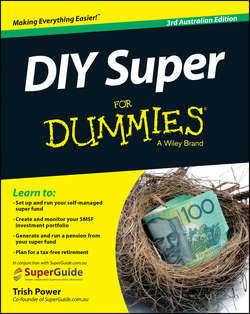Читать книгу DIY Super For Dummies - Power Trish, Trish Power - Страница 5
Part I
Taking Control of Your Super
Chapter 1
Is DIY Super Right for You?
Taking Control is a RIPper Plan
ОглавлениеTaking an interest in your super savings is always a good thing. Stepping into the role of superannuation trustee, however, is lifting your interest to a whole new level. Taking total control of your superannuation benefits isn’t necessarily a difficult task, but it does require a different way of thinking; after all, the buck stops with you – every time – as a DIY super trustee.
In the good ol’ days (think right up to the 1970s), Australians generally worked from the age of 15 until the age of 65 (unless you were a married woman and then you may not have been allowed to work at all). Your employer paid you a wage that hopefully enabled you to buy a house and feed the kids, and that helped you prepare your children for a life at least as good as, and hopefully better, than your own.
If you were still alive at age 65, you were entitled to receive the Age Pension (at age 60 if you were a woman) – most retired Australians relied mainly on the Age Pension. If you were one of the very lucky, and loyal, employees of a large company or a government department or authority, then you were likely to receive a guaranteed superannuation pension for the rest of your life. After you died, and if you were fortunate, your wife – until relatively recently, only men were entitled to join these types of company or public-sector pension schemes – would continue to receive a reduced pension from the company or public sector fund.
Today, some lucky Australians still receive a lifetime pension from a public-sector fund or corporate fund. Everyone else has to fend for themselves. The federal government has made it clear that saving for your retirement is your responsibility, although it has thrown in a few tax incentives to make that task a lot easier (for info on these incentives, see Chapter 13).
The government’s grand plan – Australia’s Retirement Income Policy (RIP) – has four limbs that the federal government is banking on to raise the standard of living of Australians in retirement:
✔ Age Pension: The federal government provides a basic Age Pension, which is a safety net for those who are unable to fully provide for themselves in retirement, although the majority of retirees receive some Age Pension payment (I explain how your super affects your Age Pension entitlements in Chapter 20, and on my SuperGuide website at www.superguide.com.au).
✔ Superannuation Guarantee (SG): Superannuation Guarantee is the official term for compulsory super contributions made by employers on behalf of their employees. Australian employers have contributed the compulsory 9 per cent SG contribution from 1 July 2002 until 30 June 2013 (and contributed a lower rate from July 1992 until June 2002). The SG rate then increased to 9.25 per cent for the 2013–2014 year and increased again to 9.5 per cent for each year from 1 July 2014 until 30 June 2021. The SG rate will gradually increase to 12 per cent by July 2025 (see Chapter 4 for more info on SG and how your SG entitlements are calculated).
✔ Tax concessions for voluntary super contributions: The government provides tax incentives to encourage you to make voluntary super contributions, and to take an income stream (super pension) in retirement (see Chapters 4, 13, and 18).
✔ Co-contribution scheme: The government puts extra money in your super account, known as a co-contribution, if you make after-tax super contributions and your income is below a certain threshold (see Chapter 4).
You can take advantage of the government’s RIP without having to run your own super fund (and Chapter 2 takes you through some of the super basics), but if you’re reading this book, you’re probably already asking yourself: Are my superannuation and retirement needs being looked after in my existing super fund? If the answer is ‘no’, you have some decisions to make.
